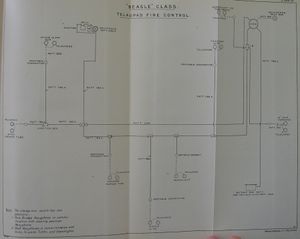Beagle Class Destroyer (1909)
Sixteen destroyers of the Beagle Class were ordered as part of the 1908-1909 Naval Programme.
They inaugurated the use of 21-in torpedoes on Royal Navy destroyers. They were re-designated the "G" class in October 1913.
Armament
Guns
- One 4-in QF Mark VIII gun forward
- Three 12-pdr 12 cwt guns, two in echelon on the beam and one aft
Torpedoes
Two single 21-in tubes on the centre line, one right aft, firing the short 18.5-foot Mark I.[1]
Control
The ships were probably completed with the Navyphone and Telaupad circuitry outlined in the Handbook of Fire Control Instruments, 1909[2] for control of gunnery, searchlights and torpedoes. It was powered by six Pattern 1453 cells.
Each gun, torpedo tube and searchlight had a set of telaupads, and there were navyphones on fore bridge (a Pattern 863) and in the aft steering position (a Pattern 2140A).
The C.O.S. on the fore bridge had two positions:
- Fore bridge Navyphone tied to after steering position Navyphone
- both Navyphones in communication with all Telaupads
By 1915, at least, these ships also had fixed voice pipes installed between decks with the last lengths being flexible (one voice pipe for gunnery, one for torpedoes) fitted between bridge and guns, torpedo tubes, and searchlights. A third voicepipe, entirely flexible, ran from bridge to the forward gun.[3]
Fire Control Instruments
See Also
Footnotes
Bibliography
